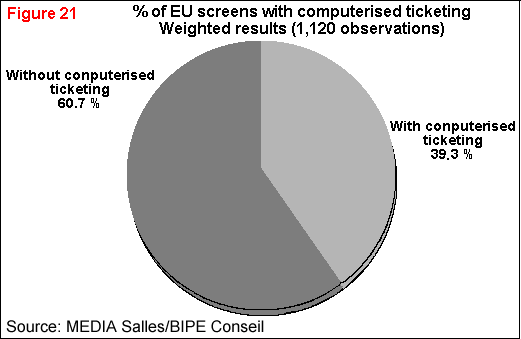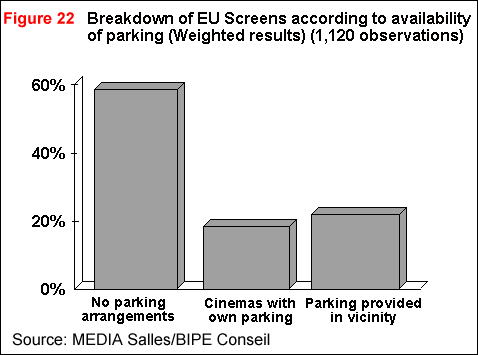4
The Commercial Position of the Cinemas
4.1 Technical equipment
Principal indicators
The indicators chosen to define the level of technical quality and
cinema modernisation, shown in Table 25, firstly
take into account the sound system (particularly the percentage of cinemas
equipped with Dolby); this is probably the most obvious sign of the level
of cinema modernisation. The proportion of single-screen cinemas in the
industry, and the proportion of multiplexes, as well as the level of computerised
ticketing have also been measured. Finally, screen density which is closely
associated with population density, reveals how easy access is to a cinema.
This completes the list of criterion for examining the level of cinema
modernisation.
On the other hand, we have not considered the proportion of large format
screens (too complex to evaluate) or the number of connected products on
offer (catering, etc.)(5) which is linked
to cultural habits (a bar or restaurant often form part of the cinema establishment,
particularly in Southern countries) and which do not necessarily constitute
a criteria for modernisation.
(5) These are analysed below.
The position country by country
In this context, there are stark contrasts between the various European
industries. Three groups of countries can be identified as follows:
· Countries where
cinemas in general are of good quality
Firstly, Belgium and Great Britain, where cinema renovation has occurred
most recently, coinciding with the growing influence of the multiplexes.
It is in these countries that most of the modernisation statistics (percentage
of screens with Dolby, percentage of screens with computerised ticketing,
percentage of multiplexes) are highest.
Germany, Denmark and the Netherlands also offer the public good quality
cinemas; their renovation has sometimes been carried out with government
help (particularly in Denmark and the Netherlands, where only municipal
cinemas benefit from subsidies for renovation). In France, cinema quality
is quite good, although varied, and is linked to the strategy of the three
main circuits and certain independents of creating multiplexes as well
as the modernisation policy in rural areas. But many single-screen cinemas
still remain in France and Germany which are both ancient and less well-equipped
(especially for sound).
Countries where some of the sector satisfies quality
criteria
In Spain, recent investment has enabled improvements in technical levels
in a part of the sector, but there is a considerable number of insufficiently
equipped cinemas alongside these modern cinemas.
In Ireland, where a watershed divides the independently owned cinemas
and the multiplexes.
Countries where, in general, cinemas have not benefitted
from the investment necessary for modernisation
These include Italy, Portugal and Greece. In Italy the lack of financing
means for new cinemas has not allowed the construction of multiplexes.
In Portugal it is undoubtedly lack of competition which explains the situation;
the operators have no incentive to modernise their establishments. Modernisation
will only occur as a result of the advent of the multiplexes. In Greece,
the industry has not benefitted either from the attention of the authorities
or the large international groups, and sites are very run down, clearly
below European standards.
The position regarding type of cinema
It comes as no surprise that, on average, facilities such as computerised
ticketing and Dolby sound are mostly the prerogative of the multiplexes
(they account for 90% of computerised ticketing systems, as opposed to
only 7% for single-screen cinemas), and the same applies, in lesser proportions,
for the split between circuits and independent cinemas. By contrast, 16mm
film projection is confined to less popular cinemas and films, in municipal
cinemas and the like.
The presence of powerful circuits generally goes hand in hand with good
quality cinemas. These companies effectively have the capacity to finance
the necessary renovation policies themselves; this is far from being the
case for the independently owned cinemas. We should emphasize that, in
France, this policy of renovation has been actively supported by the authorities,
the investment subsidy being defined by the amount of levy on tickets sold
(TSA).
However, this general rule has exceptions:
-
Any monopoly curbs the propensity to invest and improve the quality of
service to the consumer. This is the situation in which Portugal finds
itself, and cinemas there remain run down.
-
On the other hand, against all the odds, the absence of dominant circuits
has not hampered Germany from undertaking a continuous renovation of its
cinemas.
Whatever the country and the type of cinema, ease of access to the
cinema and, particularly, availability of parking, is still very limited:
60% of cinemas do not offer privileged access to a car park, and this percentage
increases the larger the population catchment area served (i.e. inner cities
are worse).
|
Table 25: Analysis of Cinema Facilities
|
| |
Density
Number of Screens per 100,000 Population
|
Sound Quality
% with Dolby
|
Cinemas
% with more than 6 Screens
|
Cinemas
%
Single Screen
|
Ticketing
% with computerised ticketing
|
General Indicator
|
| Belgium |
**
|
***
|
***
|
***
|
***
|
***
|
| Denmark |
***
|
**
|
**
|
**
|
**
|
**
|
| France |
***
|
**
|
***
|
**
|
*
|
**
|
| Germany |
**
|
**
|
**
|
**
|
***
|
**
|
| Greece |
*
|
*
|
-
|
*
|
*
|
-
|
| Ireland |
**
|
**
|
***
|
***
|
**
|
**
|
| Italy |
**
|
**
|
*
|
*
|
*
|
**
|
| Netherlands |
*
|
***
|
*
|
***
|
***
|
**
|
| Portugal |
*
|
*
|
**
|
*
|
*
|
*
|
| Spain |
**
|
**
|
**
|
*
|
**
|
**
|
| UK |
*
|
***
|
***
|
***
|
***
|
***
|
| EU Average |
**
|
**
|
**
|
**
|
**
|
**
|
| Source: MEDIA Salles/BIPE Conseil |
|
Table 25b: Legend to table 25 - Methods
of estimating quality levels
|
| |
*
|
**
|
***
|
Density
Number of Screens per 100,000 Population |
1.5 < x < 4
|
4 £ x £
6
|
6< x < 8
|
Sound Quality
% with Dolby |
10% < x < 30%
|
30% £ x £
55%
|
55% < x
|
Cinemas
% with more than 6 Screens |
0.5% < x < 5%
|
5% £ x £
15%
|
15% < x
|
Cinemas
% Single Screen |
x > 60%
|
30% £ x £
60%
|
x < 30%
|
Ticketing
% with computerised ticketing |
0% < x < 20%
|
20% £ x £
35%
|
x < 35%
|
General Indicator
Total number of points |
5 < x < 7
|
7 £ x £
12
|
x < 12
|
| Source: MEDIA Salles/BIPE Conseil |


|
Table 26: Percentage of cinemas equipped
with computerised ticketing
|
| Single-screen cinemas |
7.1%
|
| 2 screen complexes |
30.8%
|
| 3 to 5 screen complexes |
50.4%
|
| 6 to 7 screen complexes |
62.3%
|
| Complexes with 8 or more screens |
90.0%
|
| All Screens |
39.3%
|
| Source: MEDIA Salles/BIPE Conseil |
|
Table 27: Percentage of cinemas equipped
with computerised ticketing
|
| Cinemas belonging to a circuit |
63.7%
|
Independently owned
cinemas |
17.3%
|
| Cinemas owned by public authorities, or a non-profit
making organisation |
24.1%
|
| Source: MEDIA Salles/BIPE Conseil |
|
Table 28: Projection equipment
|
| |
16mm Projector
|
35mm
Projector
|
70mm
Projector
|
| All Screens |
9.1%
|
99.0%
|
5.8%
|
| Cinemas belonging to a circuit |
4.5%
|
98.9%
|
5.1%
|
| Independently owned cinemas |
8.5%
|
99.2%
|
5.8%
|
| Cinemas owned by public authorities, or a non-profit
making organisation. |
43.2%
|
98.2%
|
11.5%
|
| Source: MEDIA Salles/BIPE Conseil |
Conclusions
The level of cinema modernisation is varied. The creation of cinema
complexes brought with it in the 1980s the rise of modern multiplexes,
but the next stage, which consists of equipping the cinemas with top of
the range equipment (stereo; catering infrastructures) has only been carried
out by the circuits and a handful of independent cinema owners in countries
where the government has not implemented a policy of renovation, or where
the appearance of the multiplexes has been delayed. The influence of the
multiplexes on the average quality of cinemas is evident, in countries
like the United Kingdom, Belgium or even Germany. For the spectator, the
development of the multiplexes meant cinemas endowed with a technical quality
and comfort hitherto unknown. Moreover, this increased competition constituted,
without doubt, an incentive for other operators, forcing them to make a
considerable effort to modernise. This explains why the Belgian cinema
industry is, from the technical point of view, one of the best in Europe.
Amongst the countries in southern Europe, Spain boasts the best conditions:
the rate of installation of Dolby systems, and the proportion of multiplexes
clearly ranks it higher than Greece or Portugal.






